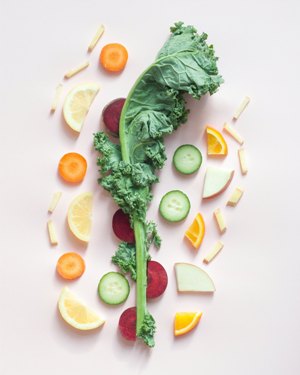
“Hmm, I really want that donut, but I should probably just eat an apple instead…”
Do you relate to this inner dialogue?
For years, choosing the “good” foods over the “bad” ones was basically my outlook on nutrition and on eating a healthy diet. This is how my (subconscious) philosophy went: Some foods are high-carb, high-fat, high-sugar and “BAD”; while others are healthy, i.e., low carb, low sugar, and “GOOD”. Mainly try to eat the good ones in order to stay thin and not clog your arteries. End of story.
Or so I thought. Until I became a student of nutrition and integrative health, and I learned there is a whole world within food. Food is built of calories, yes, I knew that. I also knew that food is built of carbohydrates, fats, and proteins. But that’s about where my knowledge ended.
Did I know that some carbohydrates contain fiber, prebiotic starches, and resistant starches that feed our microbiome—the good bacteria hanging out in our gut—while our bodies use the breakdown products for fuel? Did I realize that proteins are built of amino acids—some essential (as our bodies don’t make these) and some non-essential (which our bodies make), which compose the structures of our very cells, tissues, and organs? Did I know that healthy fats support our brain health, heart health, and hormonal health? Did I know that fats float to the top of the digesta, keeping us full between meals, while helping our bodies slowly release calories to fuel our cells?
The miraculous wonders of our food don’t end there. Healthy, whole foods are teeming with vitamins and minerals necessary for the very functions that keep us alive and well. Fruits and vegetables are chock-full of phytonutrients and antioxidants that help repair our cells and get rid of damage-causing particles. Fermented foods, such as yogurt, kefir, and sauerkraut, are full of probiotics, good bacteria which have only recently been linked with digestive health, psychological health, and even heart health.
The world of vitamins is stunning and vast: Folate in black-eyed peas, spinach, broccoli, and liver. Vitamin C in bell peppers, oranges, and kiwis. Vitamin D in salmon, tuna, sardines, and egg yolks. Vitamin B6 in turkey breast, beef, pistachios, and pinto beans. And don’t forget about the minerals essential for our body’s smooth functioning! Calcium in broccoli, kale, nuts, and okra. Magnesium in spinach, cocoa, pumpkin seeds, and avocado. Zinc in beef, turkey, nuts, and legumes. Potassium in bananas (of course!), acorn squash, avocado, and dried apricots. The list of nutrients we need for our body’s optimal performance, as well as the foods they are found in, is endlessly breathtaking.
Phytonutrients are special compounds found in plant foods, with each color containing its own profile of health-boosting, microscopic compounds. They are literally a rainbow of color created by Hashem—not only a feast for the eyes, but a spa treatment for every cell in our bodies, as well!
And then (cue spooky music, please), there is the other end of the spectrum. Ba-du-du-dummmm. The SAD diet, also known as the Standard American Diet. This consists of the nutrient-poor, overly-processed foods that stare us in the face everywhere we go: The refined sugar-laden, high-fat (not the good kinds), calorie-dense foods that are so easy to grab and eat on the run. The ones that are so tempting and so addicting. The dull foods that are brown and white and beige, and also those that are colored with chemical dyes. Think: Fries, bun, hamburger. Pretzels, chips, cookies. Fried chicken, pasta, instant potatoes—all shades of brown. Or jelly beans, lollypops, taffies. Sugar cereals, BBQ tortilla chips, mint ice cream—all colored with artificial colors to make them appetizing.
These foods are usually very high in calories, while providing little to no health-promoting nutrients. They are also often very low in protein and in the healthy kinds of compounds that nourish our cells, but rich in both processed carbs, which spike our blood sugar and burden our pancreas, and processed fats which increase inflammation and disease. These foods are also full of additives—colors, flavors, preservatives—which enhance shelf-life while covering up unsavory tastes, smells, or colors. In short, these foods are the paupers of the food spectrum.
Now, I know that was kind of heavy. It’s a lot to absorb (and, okay, a bit dramatically presented). This doesn’t mean that there isn’t a place for a treat here or there; a “nutrient-pauper” which you are indulging in for a special occasion. But, I now realize that food is about so much more than calories and what makes you fit back into that dress you used to love wearing. Food is about NOURISHMENT.
When choosing the foods that we put into our mouths or that we serve to our families, are we choosing mostly the nourishing princes or the poor paupers? Are we choosing foods rich in the compounds, which will not only keep us full, but also keep us healthy and well in the long run? Are we eating a rainbow of G-d-given produce? Are we treating ourselves to the healthy fats found in avocadoes, olive oil, salmon, tuna, nuts, seeds, and eggs? Do we focus on carbohydrates that will be kind to our sugar-regulating pancreas; those which are full of fiber, like whole grains and vegetables? Do we make sure we are getting enough protein to repair and build our cells—whether from plant or animal sources?
It may seem overwhelming at first, but making small changes to choose nutrient-dense foods will add up until you’ve overcrowded your plate and diet with life-sustaining nourishment. When we realize that the apple is full of fiber, vitamin C, cancer-inhibiting antioxidants, anti-inflammatory quercetin, cholesterol-lowering pectin, potassium, boron, vitamin K, and vitamin B6, then the sugar-loaded, fried donut may just not seem as alluring anymore.
Here’s to your journey—whichever part you may currently be on—to increasing those awesome, G-d- given, health-enhancing, nourishing, princely foods in your daily diet. L’Chaim!